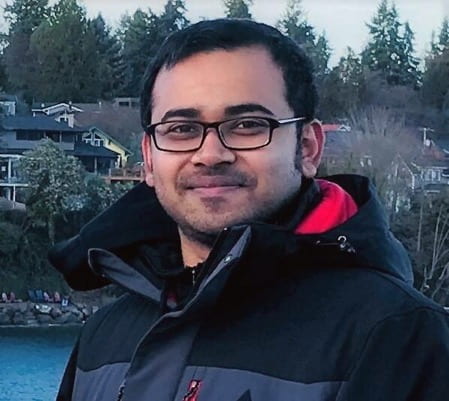Tell us a little about your background
I am from Bangladesh, a beautiful riverine country in South Asia. The country is home to the world’s largest delta, GBM (Ganges-Brahmaputra-Meghna) that drains into the Bay of Bengal. The low-lying elevation of the country and its numerous river systems have made it an extremely vulnerable location for coastal disasters, which drives my fascination toward flood hazard related studies. I received my Bachelor of Science degree in Civil and Environmental Engineering with a focus on Water Resources from Shahjalal University of Science and Technology. For my thesis project, I developed a river bank line migration modeling system that helped recognize critical river meanders prone to severe erosion. After arriving here in the US, at the beginning of my graduate student life, I have worked with Dr. Celso Ferreira at George Mason University and received an MS degree in Civil Engineering (Water Resources). My master’s research project involved dealing with a coastal engineering problem, storm surge and coastal flood hazard in the Chesapeake Bay, VA.
Why did you choose to study at the University of Delaware, Center for Applied Coastal Research?
While studying for my masters, I started to learn more about the fundamentals of Coastal Engineering by going through literature and I became familiar with the research institutions in the US. At the same time, I joined an email list famously called ‘The Coastal List’ used by coastal engineers/scientists all over the world, and found that this group was established by Dr. Robert Dalrymple of the Center for Applied Coastal Research (CACR) at the University of Delaware (UD). Subsequently, I discovered that the CACR at UD is one of the oldest coastal engineering labs in the nation. It also has a notable alumni group working in the government, private sector and academic positions. Fortuitously, during the first year of my master’s in 2014, the first YCSEC-NA conference (Young Coastal Scientists and Engineers Conference – North America) was held at UD, organized by Dr. Jack Puleo and others. I jumped at the opportunity to visit the University and share my research with other participants. During the visit, I met many CACR students, learned about their ongoing research and became really fascinated by their cohesiveness. I also listened to the keynote presentation of Dr. James T. Kirby (CACR, UD) and wished to work with him in the future.
What was your masters research on?
During my masters in George Mason University, I developed hurricane storm surge modeling frameworks for the Chesapeake Bay, VA and the Bay of Bengal using a multi-model and multi-resolution approach. Both systems are able to capture fundamental forcing process of the storm surge at a regional level, identified vulnerable coastal zones to flood and waves, and ultimately provided geospatial information necessary to more accurately quantify the benefits of wave and surge attenuation by coastal wetlands.
What are your research plans for your PhD?
I am currently working under the supervision of Dr. James T. Kirby and my ongoing research work includes field data processing, and hydrodynamic and wave modeling on the salt marshes in Delaware Bay. My PhD project has a good practical application that involves hurricane surge modeling, coastal wetland loss/gain prediction and restoration scenario assessment. I have developed a coupled hydrodynamic, wave and sediment transport model for 13,000 acres of salt marshes in one of the largest wetland systems in the U.S. mid-Atlantic region, Bombay Hook National Wildlife Refuge, DE. I am also conducting different type of field deployments to validate my model performance, where I collect topo-bathymetric, water surface elevation, and current velocity data inside the Refuge and the Delaware Bay. The outcomes of my study will be applied to develop wetland loss mitigation strategies and long-term resilience planning for the Refuge, and could potentially help to prevent erosion in other major wetland systems around the world.
What do you find rewarding about your research?
The most rewarding part for me is the learning through working. I have learned so many things from the last couple of years, mainly about how to tackle a large-scale coastal engineering problem that involves interaction between all the critical processes such as hydrodynamics, wind waves and sediment transport. This required me to use all of the various experiences and knowledge gained throughout my research and studies.
What are your tentative plans after you obtain your PhD?
I would like to keep learning, and dream to join a dynamic national research lab/institution like the Woods Hole Oceanographic Institution (WHOI), National Oceanic and Atmospheric Administration (NOAA) or Pacific Northwest National Laboratory (PNNL) as a post-doctoral scholar where I can get to learn from other coastal scientists.
What do you do for fun outside of your PhD studies?
Fun outside CACR? It’s a tough question. Let me guess…
Okay, just kidding. I like to watch sports, mainly cricket (it’s close to the US baseball) and soccer (called Football in Asia). Beside this, I like to travel places, meet new people and know more about their food and culture.

